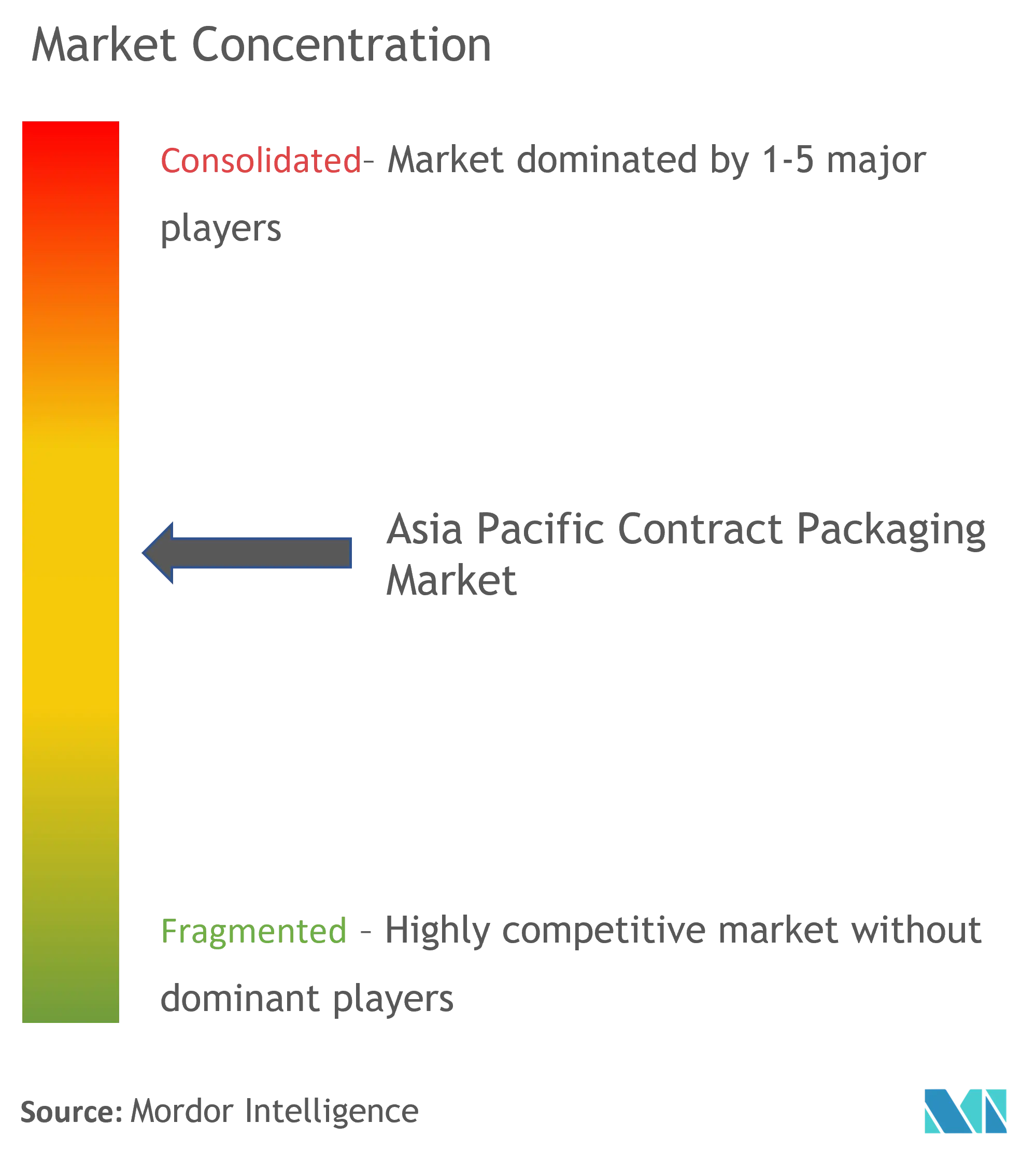
Asia Pacific Contract Packaging Market Analysis by Mordor Intelligence
The Asia Pacific Contract Packaging Market is expected to register a CAGR of 12% during the forecast period.
- Asia-Pacific contract packaging market growth is mainly influenced by the changing manufacturing firms' preferences, who usually outsource packaging activities to third-party players. It is because manufacturers are increasingly focusing on cost optimization and their core business.
- Contract packaging provides several advantages. Firstly, it reduces the operational costs of the manufacturers. The operating costs can be reduced by 7% to 9% by outsourcing packaging activities to contract packagers due to the reduced costs of machines and lowered labor costs.
- The customers in the market look for bonded zones for co-packaging in China. Some bonded zones include coastal zones such as Guandong, Zhejiang, Shanghai, and Futian. They have robust trade and port networks, no Customs Duty for products made out of China, No Export Licensing Issues, and No Supplier-Client Tracking. Some significant vendors operating in bonded sones are GPA Global, Asiapack, and Presence Asia Group.
- India is currently witnessing an increase in demand for contract packaging due to the sudden surge in medication consumption and increased vaccine production from various pharmaceutical industries. The Serum Institute of India (SII), one of the largest vaccine producers, manufactures AstraZeneca's Covishield and another formulation developed by US rival Novavax Inc. It increases opportunities for vendors in the market to introduce filling services to cater to the increased vaccine production during the second COVID-19 wave. There is also an impact of the Russia-Ukraine war on the overall packaging ecosystem.
- Australia is also witnessing robust growth for co-packaging services, with significant developments and investments made by various pharmaceutical industries worldwide. For instance, PCI Pharma Services (PCI) acquired Australia-based Pharmaceutical Packaging Professionals (PPP), one of the leading packaging, storage, distribution, and trial manufacturing providers. It caters to the need for commercial co-packing services in the region.
- In the current scenario, manufacturers require a variable cost structure based on volume. This volume might differ from a small quantity ranging from 100 l to a large one. However, packaging a minimum order might result in a loss for contract packagers, owing to its total costs, which could lead to manufacturers needing more time to outsource their projects.
Asia Pacific Contract Packaging Market Trends and Insights
Pharmaceutical Sector is Observing Significant Growth
- Co-packaging allows vendors to adapt to variations specific to a dynamic market, like Pharmaceuticals. Production line flexibilities help companies prevent repackaging work, reduce working capital, and lower finished goods inventories.
- In the Asia-Pacific region, the Chinese Pharmaceutical market offers enormous opportunities as more and more people gain access to Traditional Chinese Medicine (TCM) and Western medicine, produced in huge volumes. For the same reason, China became the most significant market for high-speed blister packaging.
- While API manufacturing is typical in China, most of the country's CMOs are limited to manufacturing liquid or solid dosage formulations. It is expected to increase the demand for co-packaging services on primary, secondary, and tertiary levels, such as blister packaging, plastic containers, and labeling, among others, for major pharmaceutical companies in the country.
- India is currently witnessing an increase in demand for contract packaging due to the sudden surge in medication consumption and increased vaccine production from various pharmaceutical industries. In addition, the country is also known for being one of the largest producers of Ayurvedic and Homeopathic medicine and skincare.
- India is the world's No. 12 exporter of medical supplies. More than 200 nations worldwide receive Indian medications for export, with the US serving as the primary market. The country is the world's leading supplier of generic medicines, with 20% of global exports made up of generic drugs. In FY22 and FY21, Indian medication and pharmaceutical exports totaled USD 24.60 billion and USD 24.44 billion, respectively. In June last year, Indian pharmaceutical and medicine exports totaled USD 2,119.08 million.

Secondary Packaging is One of the Factor Driving the Market
- The increasing need for physical and barrier protection, secondary containment, adherence to regulations, and safety increased secondary packaging adoption. Standard secondary packaging includes cardboard cartons, cardboard boxes and cardboard/plastic crates, small inflatable air pillows, bubble wrap, loose-fill, and labels.
- As secondary packaging involves a packaging level within it, it is the secondary packaging that the consumer gets to see first, making it of prime importance. It is propelling the players in the industry to outsource the packaging that enables them to increase the product's attractiveness and henceforth attract customers. Thus, it boosts market growth over the forecast period.
- Globally, secondary contract packaging plays a vital role for pharmaceutical companies that want to focus solely on developing the drug. In such cases, the company employs packaging companies on a contract basis. It is likely to let them focus on the R&D of the product while the packaging duties of the product for transportation are outsourced.
- Secondary packs are often the first interaction with the brand consumers have, whether online, in-store, or at any point in between. Brands have associated themselves with a typical packaging type so that their products are identified on aisles.
- In the current packaging market scenario, outsourcing secondary packaging is becoming increasingly popular, owing to the rise of e-commerce and retailing. Thus, it aids manufacturers in undertaking large projects without needing extra workforce or machinery while also enabling the company to strengthen its distribution channels.

Competitive Landscape
The Asia Pacific Contract Packaging market needs to be more cohesive. Regional market development and increasing local players' shares in foreign direct investments are the major factors promoting the fragmented nature of the market. Some of the players operating in the market Central Glass, MJS Packaging, Stamar Packaging, TricorBraun, Premier Packaging, and Sharp Packaging Services are some of the players.
- July 2022 - Sharp, a global provider of contract packaging and clinical supply services, partnered with ClinsChain, a company with operations in China, to increase its presence and capabilities. To help Sharp's pharma and biopharma clients gain access to the Chinese market while also assisting Chinese innovators in expanding their global footprint, Sharp will work with ClinsChain. This company provides clinical supply services for regional and international clinical trials.
Asia Pacific Contract Packaging Industry Leaders
-
Premier Packaging
-
TricorBraun
-
Central Glass
-
MJS Packaging
-
Stamar Packaging
- *Disclaimer: Major Players sorted in no particular order

Recent Industry Developments
- October 2022 - Mold-Tek Packaging was awarded a contract by Grasim Industries' Paints Division to supply packing materials (PAILS). As a result, a co-located plant will be built in Panipat to meet their needs. By the end of the current year, the new facility should be set up and running. A total of about Rs 30 crore (~USD 3.68 million) would be invested in the project. Further, to meet the demand for these goods in Northern India, the business wants to establish food and FMCG IML container production facilities in Panipat.
Asia Pacific Contract Packaging Market Report Scope
Contract packaging is assembling a product or good into its final finished packaging. Depending on the product, the final packaging constitutes various forms, such as thermoformed/ plastic clamshell or blister packaging, a plastic bag, a standing corrugated retail point-of-sale display, or a transport tray.
The Asia Pacific Contract Packaging market is segmented by service (primary packaging, secondary packaging, tertiary packaging), end-user vertical (beverages, food, pharmaceuticals, home and fabric care, beauty care, and others), and country (China, India, Japan, Australia, and others). The market sizes and forecasts are in terms of value (USD million) for all the above segments.
| Primary Packaging |
| Secondary Packaging |
| Tertiary Packaging |
| Beverages |
| Food |
| Pharmaceuticals |
| Home and Fabric Care |
| Beauty Care |
| Others |
| China |
| India |
| Japan |
| Australia |
| Others |
| By Service | Primary Packaging |
| Secondary Packaging | |
| Tertiary Packaging | |
| By Vertical | Beverages |
| Food | |
| Pharmaceuticals | |
| Home and Fabric Care | |
| Beauty Care | |
| Others | |
| By Country | China |
| India | |
| Japan | |
| Australia | |
| Others |
Key Questions Answered in the Report
What is the current Asia Pacific Contract Packaging Market size?
The Asia Pacific Contract Packaging Market is projected to register a CAGR of 12% during the forecast period (2025-2030)
Who are the key players in Asia Pacific Contract Packaging Market?
Premier Packaging, TricorBraun, Central Glass, MJS Packaging and Stamar Packaging are the major companies operating in the Asia Pacific Contract Packaging Market.
What years does this Asia Pacific Contract Packaging Market cover?
The report covers the Asia Pacific Contract Packaging Market historical market size for years: 2019, 2020, 2021, 2022, 2023 and 2024. The report also forecasts the Asia Pacific Contract Packaging Market size for years: 2025, 2026, 2027, 2028, 2029 and 2030.
Page last updated on:
Asia Pacific Contract Packaging Market Report
Statistics for the 2025 Asia Pacific Contract Packaging market share, size and revenue growth rate, created by Mordor Intelligence™ Industry Reports. Asia Pacific Contract Packaging analysis includes a market forecast outlook for 2025 to 2030 and historical overview. Get a sample of this industry analysis as a free report PDF download.



